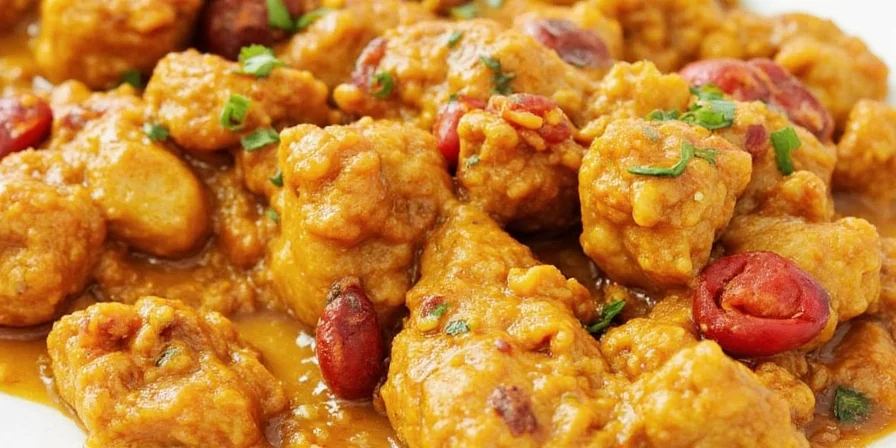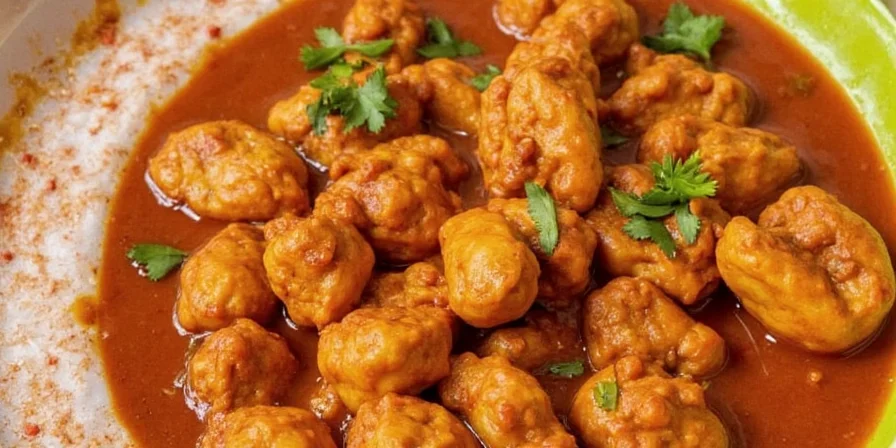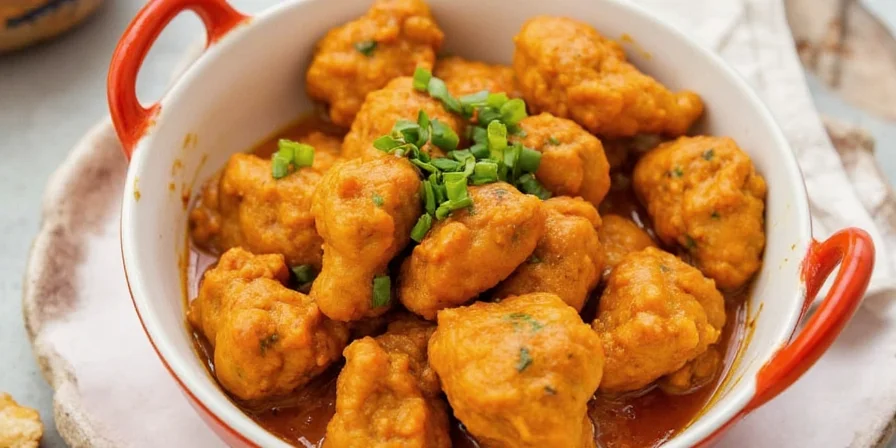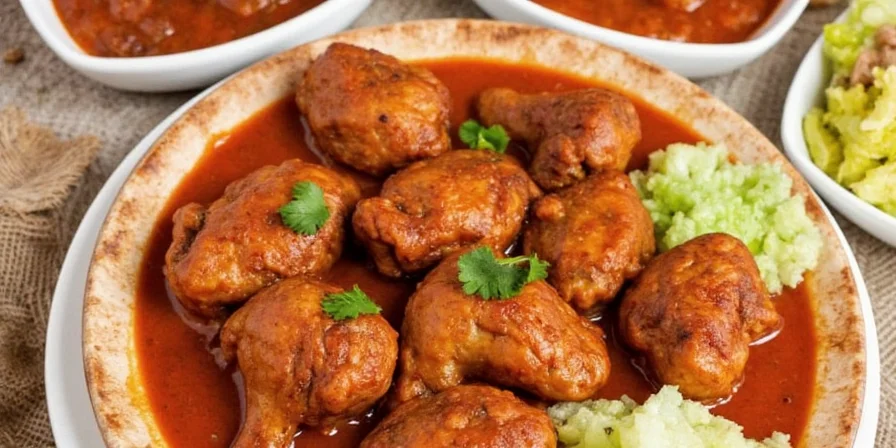Looking for an authentic Indian Butter Chicken recipe that delivers restaurant-quality results at home? This complete guide provides exact measurements, cooking times, and professional techniques to make perfect Butter Chicken without specialized equipment. Get the full recipe below with step-by-step instructions followed by expert tips that transform good curry into extraordinary curry.
Authentic Butter Chicken Recipe (Serves 4)
Ingredients
- 500g boneless chicken thighs (cut into 1.5-inch pieces)
- 1 cup full-fat plain yogurt
- 2 tbsp lemon juice
- 1 tbsp ginger-garlic paste
- 1 tsp turmeric powder
- 1 tsp red chili powder
- 1 tsp garam masala
- 2 tbsp butter
- 1 tbsp ghee
- 2 cups tomato puree (1 can crushed tomatoes)
- 1 cup heavy cream or full-fat coconut milk
- 1 tsp kasuri methi (dried fenugreek leaves)
- Salt to taste
- 1 tbsp sugar (optional)
Step-by-Step Instructions
- Marinate chicken: Mix chicken with yogurt, lemon juice, ginger-garlic paste, turmeric, chili powder, and salt. Refrigerate for minimum 4 hours (overnight for best results).
- Cook chicken: Grill or broil chicken at 400°F (200°C) for 15-18 minutes until lightly charred. Rest for 5 minutes before cutting into bite-sized pieces.
- Prepare sauce: Melt butter and ghee in pan. Add tomato puree, sugar (if using), and salt. Simmer 15 minutes until oil separates from sauce.
- Combine: Add grilled chicken to sauce. Stir in cream/coconut milk and kasuri methi. Simmer 10 minutes on low heat.
- Finish: Adjust seasoning. Garnish with fresh cilantro. Serve with basmati rice and naan.
| Cooking Stage | Temperature | Time | Visual Cues |
|---|---|---|---|
| Chicken Marination | Refrigerated | 4-12 hours | Yogurt fully coats chicken |
| Chicken Cooking | 400°F (200°C) | 15-18 min | Light charring, internal temp 165°F |
| Sauce Preparation | Medium heat | 15 min | Oil separates from sauce |
| Final Simmer | Low heat | 10 min | Sauce coats back of spoon |

7 Expert Secrets for Perfect Butter Chicken
Secret #1: The Yogurt That Does Magic
Full-fat yogurt is essential for tenderizing chicken due to its lactic acid content. It creates a protective barrier during cooking, preventing dryness while allowing deep flavor penetration. Unlike low-fat alternatives, full-fat yogurt maintains its structure during cooking without curdling.
| Yogurt Type | Tenderizing Power | Flavor Impact | Best For |
|---|---|---|---|
| Full-Fat | High | Rich & Balanced | Traditional preparation |
| Low-Fat | Medium | Dry & Bland | Not recommended |
| Greek | Very High | Thick & Tangy | Extra tender results |
Secret #2: Marination Science Explained
Marinating for 4+ hours allows enzymatic reactions that break down muscle fibers. The critical window is 4-12 hours—less than this yields surface-level flavor, while longer than 12 hours can make chicken mushy. For food safety, never marinate at room temperature and always discard used marinade.
Secret #3: Tandoor Simulation Technique
The authentic smoky flavor comes from searing chicken at 500°F+ in a clay oven. At home, achieve similar results by:
- Preheating grill pan to smoking point
- Adding 1/4 tsp smoked paprika to sauce
- Finishing with 2 drops liquid smoke (optional)
Secret #4: Tomato Selection Guide
For optimal flavor balance, use this professional ratio:
- 60% canned tomatoes: San Marzano varieties for concentrated flavor
- 40% fresh tomatoes: Roma tomatoes blanched and peeled for brightness
This combination provides consistent results regardless of season.

Secret #5: Butter-Ghee Synergy
The perfect fat ratio is 50:50 butter to ghee. Butter provides dairy richness while ghee's higher smoke point (485°F vs 300°F) prevents burning during sauce preparation. Clarified butter alone lacks the dairy notes essential to authentic flavor.
Secret #6: Cream Alternatives Compared
While traditional recipes use malai (clotted cream), these substitutes maintain authenticity:
- Heavy cream: Simmer gently to prevent curdling
- Coconut milk: Use only full-fat, add after sauce has cooled slightly
- Yogurt: Whisk with 1 tbsp cornstarch before adding
Secret #7: The Resting Principle
Resting grilled chicken for 5-10 minutes allows:
- Protein fibers to relax and reabsorb juices
- Surface temperature to drop before sauce contact
- Flavor compounds to stabilize
This prevents sauce dilution and maintains texture integrity.

Common Mistakes to Avoid
- Using pre-cut "butcher's chicken" (thighs work better than breasts)
- Skipping the sauce reduction step (oil separation is crucial)
- Adding cream to boiling sauce (causes curdling)
- Overcooking during final simmer (max 10 minutes)


Frequently Asked Questions
How long should I marinate the chicken for Butter Chicken?
For optimal results, marinate chicken for 4-12 hours. Minimum 4 hours ensures flavor penetration, while 8-12 hours delivers restaurant-quality tenderness. Never marinate longer than 24 hours as the yogurt's acidity will begin to break down the meat excessively.
Can I make Butter Chicken without a tandoor oven?
Absolutely. Professional chefs achieve authentic results by searing chicken in a preheated cast-iron skillet at 400°F for 15-18 minutes. For the signature smokiness, add 1/4 teaspoon smoked paprika to the sauce and finish with 2 drops liquid smoke (optional). This method replicates tandoor results without specialized equipment.
What's the best substitute for cream in Butter Chicken?
Full-fat coconut milk is the most effective substitute, maintaining both texture and flavor balance. Use 1 cup of refrigerated full-fat coconut milk (not light version), adding it after the sauce has cooled to 160°F to prevent separation. The coconut flavor subtly enhances the tomato base without dominating, making it ideal for dairy-free versions.
Why does my Butter Chicken sauce separate?
Sauce separation occurs when the tomato base hasn't been properly reduced. Authentic Butter Chicken requires simmering the tomato puree until oil visibly separates from the solids (about 15 minutes). This critical step emulsifies the sauce, allowing cream to incorporate smoothly. Skipping this results in a watery, separated sauce regardless of other technique.
How can I make Butter Chicken ahead of time?
Butter Chicken actually improves with time. Prepare the sauce base (through step 3) 1-2 days ahead and store refrigerated. Grill chicken fresh when serving, then combine with pre-made sauce and simmer 10 minutes. The sauce develops deeper flavor overnight as spices meld, while fresh chicken maintains optimal texture.










 浙公网安备
33010002000092号
浙公网安备
33010002000092号 浙B2-20120091-4
浙B2-20120091-4